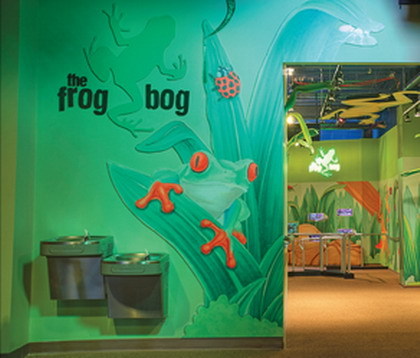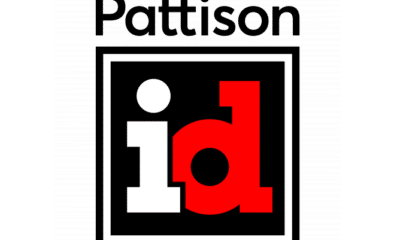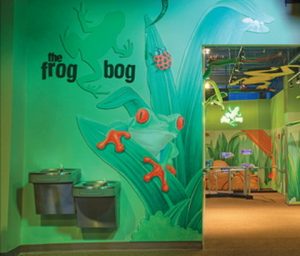Murphy Catton (Walton, KY) has produced exhibit and environmental graphics and sculptures for museums and corporate and educational environments for 25 years. Mike Murphy, president of Murphy Catton, said clients have become more knowledgeable about design possibilities and have increasingly become more specific with their requests.
“The materials used in our market constantly change,” Murphy said. “With the broad range of choices today, almost any substrate may be incorporated into an exhibit. Also, we’ve become more proactive in the search for green materials to suit growing customer demand.”
For instance, the company substitutes protein-based glues in lieu of formaldehyde and has replaced fiber boards with plywood when assembling many exhibit components. The company has also adopted bamboo as a viable exhibit ingredient; Murphy Catton uses a vendor that grows farm-raised bamboo plants rather than depleting wild-grown varieties.
Within a tough economic climate, Murphy says the exhibit industry has turned into a buyers’ market: “More companies recently emerged in the market, and, given the reduced volume of available work out there, bids have become extremely competitive, which benefits the clients’ needs. We haven’t encountered many project cancellations, but we’ve seen quite a few postponements due to financial issues. Also, more clients seek cost- rather quality-driven solutions, which makes value-engineering more important than ever.”
To create a successful exhibit solution, Lisa Hawn, a project manager for Murphy Catton, said a successful solution requires:
Advertisement
• Good communication and collaboration throughout the entire process, and a shared vision of the end result;
• Providing continued support after an exhibit’s installation; and
• The development of signage with no more verbiage than necessary to convey the message. Hawn said, “Images and graphics should express a strong message. A successful sign reaches its audience succinctly and effectively.”
Last year, Murphy Catton fabricated signage and environmental graphics for the Frog Bog, a 2,200-sq.-ft. exhibit hosted by the Newport (KY) Aquarium. The shop maintains an ongoing relationship with Aquarium officials and has produced several exhibit programs. The Frog Bog’s design entailed a joint effort between Murphy Catton, the designer, Kraemer Design & Production (Cincinnati), and the Newport Aquarium, the client.
Murphy Catton produced such interactive exhibit components as a climbing structure and sculpted-HDU rocks that approximate a “frog’s eye view,” four fiberglass sculptures that replicate distinct frog breeds with a push-button that triggers the frog‘s croak, and a Frogger-like video game where the users move on large pads to maneuver the onscreen character through mazes.
To complement these amenities, Murphy Catton created “immersive” wall graphics that feature vividly colored wall graphics that create a “conversation” about what Aquarium patrons can do to preserve frog habitats.
Advertisement
To produce the exhibit’s signage, Murphy Catton custom-cut Alcan Composities USA Inc. Sintra® composite material on its CNC router (a Weeke BHC 550) and printed the graphics on a UV-ink, flatbed printer. Other exhibits comprise routed, MDF plywood decorated with similarly printed graphics.
“It was a challenge to narrow down the many ideas the exhibit team provided, but we achieved our goal of a pro-conservation message with plenty of fun factor,” Hawn said.


 Paula Fargo2 weeks ago
Paula Fargo2 weeks ago
 Real Deal1 week ago
Real Deal1 week ago
 Photo Gallery2 weeks ago
Photo Gallery2 weeks ago
 Projects1 week ago
Projects1 week ago
 Projects2 days ago
Projects2 days ago
 News2 days ago
News2 days ago
 Business Management1 week ago
Business Management1 week ago
 News1 week ago
News1 week ago














